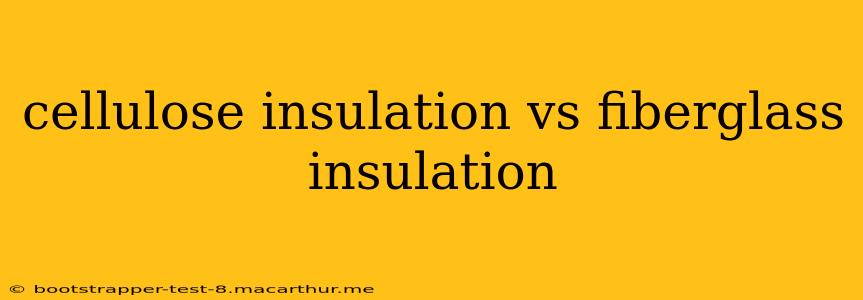Choosing the right insulation for your home is a crucial decision impacting energy efficiency, comfort, and long-term costs. Two popular options, cellulose and fiberglass, each offer distinct advantages and disadvantages. This comprehensive guide will delve into the key differences, helping you make an informed choice for your specific needs.
What is Cellulose Insulation?
Cellulose insulation is a recycled paper product treated with borates for fire resistance and pest deterrence. It's blown into wall cavities and attics, conforming to irregular spaces effectively. Its loose-fill nature makes it excellent for filling gaps and cracks, minimizing air leaks.
What is Fiberglass Insulation?
Fiberglass insulation is made from spun glass fibers bonded together. It comes in various forms: batts (rolls), blankets, and loose-fill. Batts are easy to install in standard wall cavities, while loose-fill can address irregular spaces similar to cellulose.
Cellulose Insulation vs. Fiberglass Insulation: A Detailed Comparison
Here's a breakdown comparing key aspects of cellulose and fiberglass insulation:
R-Value:
Both cellulose and fiberglass offer comparable R-values (a measure of thermal resistance). However, the R-value can vary depending on the density and thickness of the insulation. Higher R-values indicate better insulation. Often, cellulose might need a slightly higher density to achieve the same R-value as fiberglass.
Installation:
Cellulose: Typically installed by professionals using specialized blowing equipment. This ensures even distribution and proper density.
Fiberglass: Batts and blankets are relatively easy for DIY installation, while loose-fill requires professional equipment and expertise.
Cost:
Generally, cellulose insulation is slightly less expensive than fiberglass, particularly when considering the potential savings on labor if you opt for DIY fiberglass installation.
Environmental Impact:
Cellulose: Made from recycled paper, making it an eco-friendly choice. The borate treatment also contributes to its environmental profile as it reduces the need for other pest treatments.
Fiberglass: Manufacturing fiberglass involves energy consumption and the potential for airborne fibers during installation. However, recycled glass content in some fiberglass products helps reduce its environmental footprint.
Moisture Resistance:
Cellulose: Cellulose insulation has a good ability to absorb and release moisture, reducing the risk of condensation within wall cavities.
Fiberglass: Fiberglass is less moisture-resistant and can be prone to mold growth if exposed to excessive moisture. Proper vapor barriers are crucial with fiberglass insulation.
Fire Resistance:
Both cellulose and fiberglass are treated to be fire-resistant, though cellulose's borate treatment might offer a slight edge.
Sound Absorption:
Cellulose generally performs better at sound absorption than fiberglass, offering improved noise reduction.
Health Concerns:
Cellulose: The borate treatment makes it resistant to pest infestation and mold growth, thus reducing associated health risks.
Fiberglass: The fibers can irritate skin and lungs during installation. Appropriate personal protective equipment (PPE) is vital during installation.
Frequently Asked Questions (FAQs)
H2: Which insulation is better for soundproofing?
Cellulose insulation excels in sound absorption due to its denser structure and ability to trap sound waves more effectively.
H2: Is cellulose insulation more flammable than fiberglass?
Both are treated to be fire-resistant. Cellulose, treated with borates, typically exhibits slightly better fire-retardant properties.
H2: Which insulation is better for attics?
Both are suitable for attics. Loose-fill cellulose conforms well to uneven surfaces, while fiberglass batts are easier for DIY installation if you're comfortable working at heights.
H2: Can I install fiberglass or cellulose insulation myself?
Fiberglass batts and blankets are relatively easy for DIY installation, while professional installation is recommended for cellulose due to the specialized equipment required for proper density and even distribution.
H2: Which insulation is more environmentally friendly?
Cellulose, made from recycled paper, generally boasts a smaller carbon footprint than fiberglass production.
Conclusion: Making the Right Choice
The "best" insulation depends on your specific needs and priorities. Cellulose often wins in terms of environmental friendliness, sound absorption, and moisture management. Fiberglass tends to be simpler for DIY projects in certain applications, with batts and rolls requiring less specialized equipment and knowledge to install. Carefully weigh the factors discussed above and consider consulting with a qualified insulation professional to make the most appropriate choice for your home.
